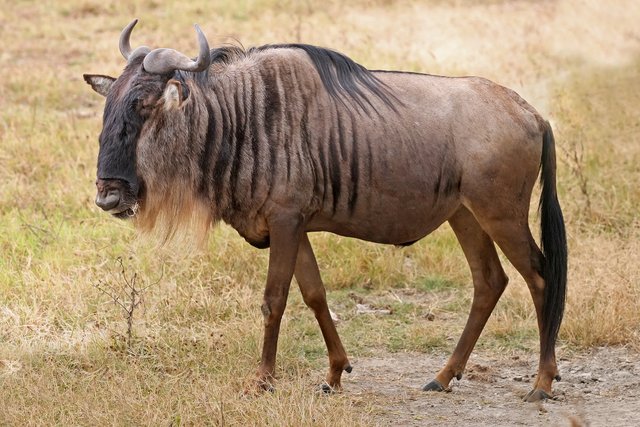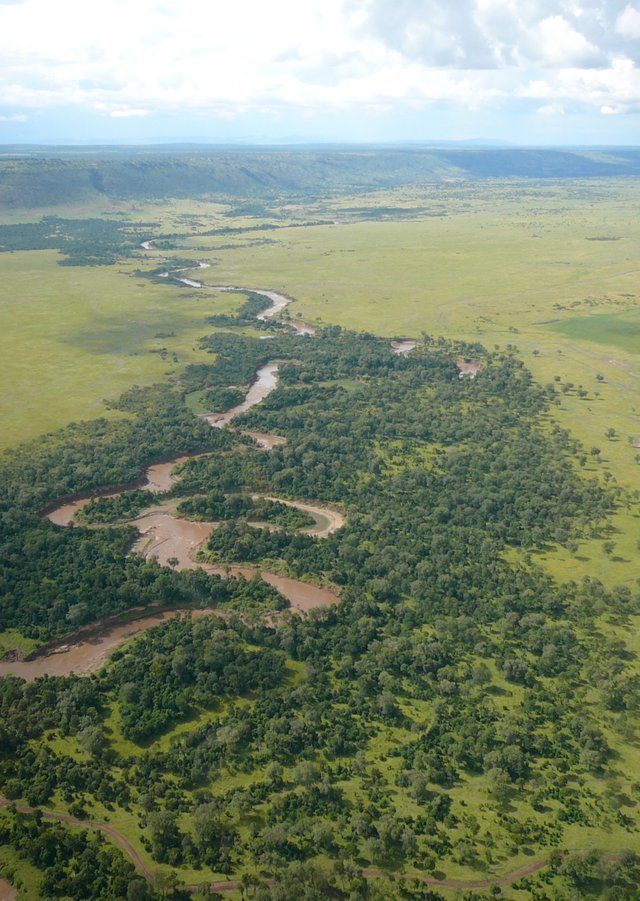During migration season over 6,000 wildebeests drown annually, but this is vital to the river ecosystem in their migration route!
The blue wildebeests (Connochaetes taurinus) that live in Serengeti, Tanzania are part of one of the greatest migrations on earth. Starting in January, the wildebeests begin one of the biggest migration journeys in the world, where they move from Serengeti to the Masai Mara reserve in Kenya. Estimations of animals in the herd are between 1,2 and 1,7 million wildebeests, but another 200,000 zebras and antelopes join the migration. They are also followed by scavengers and predators who are looking for an easy meal, so this is a gigantic multispecies migration!

A blue wildebeest. Image by Muhammad Mahdi Karim, posted with the GNU Free Documentation License, Version 1.2.
The migration is occurring annually, and these immense herds are absolutely amazing to look at. I bet you have already seen a few clips of the migration in a nature documentary, where they are commonly shown. The point of the migration is to keep finding new food, while also keeping on the move to help the calves be protected from predators.
At around March the herd will find themselves in a pretty sticky situation. They have to cross the river rapids of the Mara River, which is filled with crocodiles and other animals that would gladly eat the wildebeests. The crossing of the river is one of the most dangerous part of the migration, and roughly 6,200 wildebeests are estimated to die from drowning each year.
Just over 6,000 animals in a group of 1,2 million means that each individual animal has a high chance to survive, but this mass-drowning is still extremely important for the river ecosystem. The dead wildebeests have a combined weight of 1,1000 tons of biomass, so it provides plenty of resources to the river.
A picture from the great wildebeest migration. Image by Bjørn Christian Tørrissen, posted with the Creative Commons Attribution-Share Alike 3.0 Unported license.
A research team has calculated how the biomass gets used by looking at stable isotope analyses, nutrient tracking methods, as well as fitting scavenger birds with cameras. The finding very pretty surprising, showing that only 2 % of the drowned wildebeests is eaten by crocodiles, much less than anticipated. The other side of the coin is the common fish in the river. During the wildebeests migration, these fish gets almost 50 % of their food from their carcasses! This allows them to grow a lot more quickly during this annual period, and in time provide food for bigger animals.

Mara River in Kenya, one of the biggest challenges for the migrating herd to overcome. Image by Ryan Harvey, posted with the Creative Commons Attribution-Share Alike 2.0 Generic license.
Once the wildebeests' carcasses are picked clean, their skeleton keeps supplying the river with mineral and nutrients for around 7 years, and is one of the reasons why the river is so rich in nutrients. The bones are roughly half of the drowned biomass, which means that it is over 500 tons each year. This means that the migration is giving both short-term and long-term benefits to the river, and even a small number from the migrating herd can have huge positive benefits for entire ecosystems.
Thanks for reading
If you are interested to learn more, check out the article published in Proceedings of the National Academy of Sciences.
I have always been fascinated by this migration with all consequences!
Our world is patterned in such way, give and take rule. We all must be drawn in the river of death someday, Let's try and utilize our little moment now to touch lives positively, I'll start by up voting this wonderful post. Thanks @valth
Thanks for the upvote! I agree with your philosophy :)
Great and informative article about this migration! I learned few new things, e.g. never had thought that the bones of the drowned animals were good for something! Thanks for sharing this with us! Have a wonderful day, Valth!
I'm glad you liked the post :)
Yeah, animal bones actually provide lots of needed nutrients for many aquatic organisms. It is a great source of calcium, which can be pretty difficult to come by for many organisms, especially in freshwater.
Just a funfact I just remembered about animal bones: when whales die their bones fall to the bottom of the sea where they are responsible for creating an entire localized ecosystem, called the whale fall ecosystem. Here we find many species that are totally dependent on these whale skeletons to survive!
I hope you have a wonderful day as well, @pipurilla!
WOW, another interesting fact even in this reply! The world we live in is such a wonderful place!
Thanks for sharing your great articles with us!